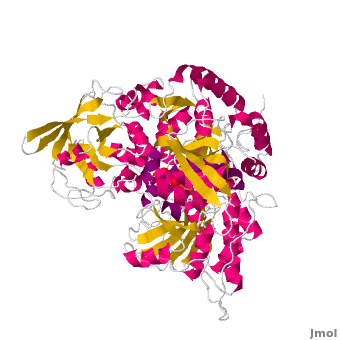Aconitase
From Proteopedia
(Difference between revisions)
m (→Catalytic mechanism of mitochondrial ACO) |
(literature) |
||
| Line 38: | Line 38: | ||
*[[8acn]] - mAc (''Sus scrofa'') with nitroisocitrate | *[[8acn]] - mAc (''Sus scrofa'') with nitroisocitrate | ||
--> | --> | ||
| + | == Literature == | ||
| + | * M. Claire Kennedy and Helmut Beinert: ''IX.4. Aconitase.'' in Ivano Bertini, Harry B. Gray, Edward I. Stiefel, Joan Selverstone Valentine (eds.): ''Biological Inorganic Chemistry: Structure and Reactivity.'' University Science Books, Herndon 2006. ISBN 1891389432 pp.209-- | ||
| + | |||
== References == | == References == | ||
<references/> | <references/> | ||
Revision as of 06:57, 8 March 2009
UNDER CONSTRUCTION
Aconitase (ACO) is an enzymatic domain that confers the ability to catalyse the equilibrium
- citrate = aconitate + H2O = L-isocitrate
This reaction is part of the citrate (TCA-, Krebs-)cycle.
In most organims, there is a cytosolic enzyme with an ACO domain (cAc), and in eukaryotes, a second copy of it was introduced with mitochondria (mAc). Plants developed even more copies in mitochondria.
Contents |
Catalytic mechanism of mitochondrial ACO
|
Cytosolic aconitase and its other function
Literature
- M. Claire Kennedy and Helmut Beinert: IX.4. Aconitase. in Ivano Bertini, Harry B. Gray, Edward I. Stiefel, Joan Selverstone Valentine (eds.): Biological Inorganic Chemistry: Structure and Reactivity. University Science Books, Herndon 2006. ISBN 1891389432 pp.209--
References
- ↑ Lauble H, Kennedy MC, Beinert H, Stout CD. Crystal structures of aconitase with trans-aconitate and nitrocitrate bound. J Mol Biol. 1994 Apr 8;237(4):437-51. PMID:8151704 doi:http://dx.doi.org/10.1006/jmbi.1994.1246
External links
Proteopedia Page Contributors and Editors (what is this?)
Michal Harel, Alexander Berchansky, Ralf Stephan, David Canner, Joel L. Sussman, Jaime Prilusky, Anthony Noles, Angel Herraez, Eran Hodis

